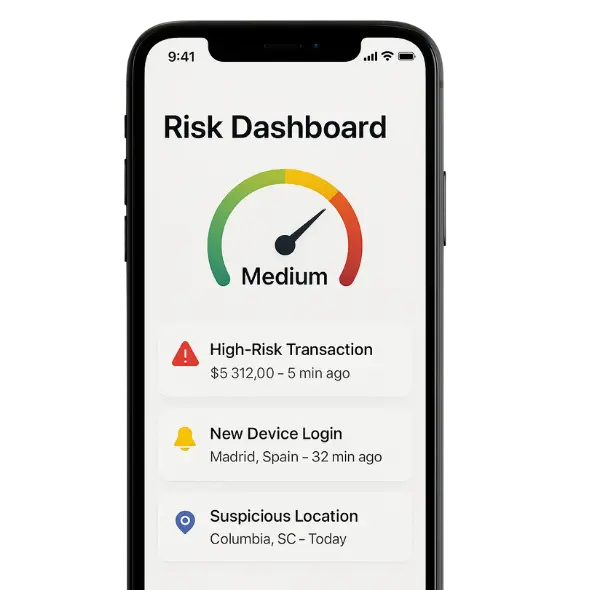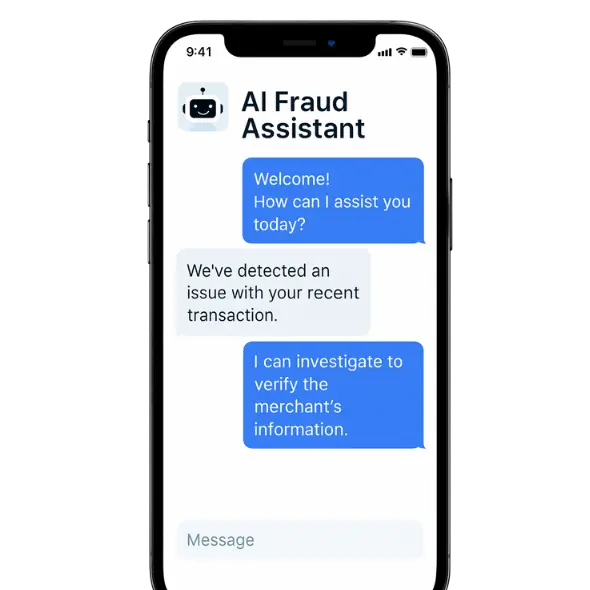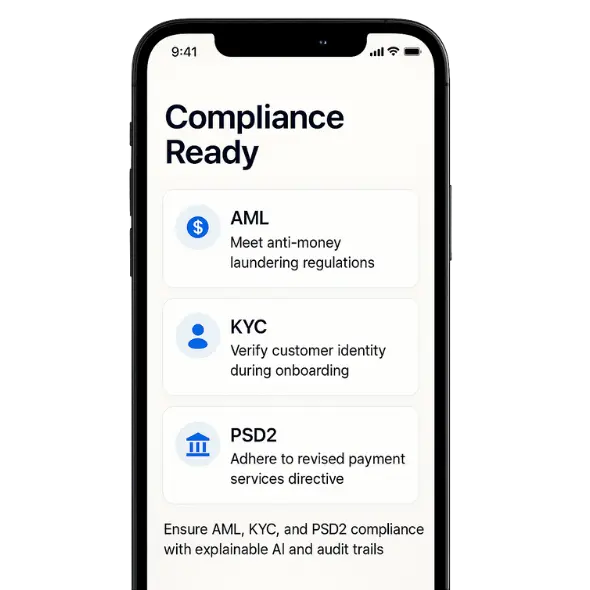
Introduction
Digital payments are growing fast. However, so are fraud risks. In 2023, global fraud losses crossed $40 billion. Criminals used bots, phishing, and synthetic IDs to bypass outdated rule-based systems.
One global fintech and payments provider faced this reality. A single fraud attack caused $500,000 in losses in one day. As a result, the company adopted an AI-powered fraud detection platform built with advanced AI development services. This solution now stops fraud in real time and protects customer trust.
Company Profile
Global fintech leader with 15M+ customers in 40+ countries, processing $100B annually.
Services
Digital wallets, P2P transfers, merchant payments, BNPL, and loans.
Market Impact
Drives global digital finance adoption for users and businesses.
Key Challenge
Growth caused 10K+ daily fraud alerts and rising customer dissatisfaction.

Secure Transaction

Risk Dashboard

Assistant

Compliances
Project Objectives
Executives needed a real-time fraud dashboard with KPIs for risk, compliance, trust, and efficiency. Any red alert triggered immediate action to stop attacks and adjust strategies.
The company launched a Fraud Prevention Transformation Program with these goals:
Detect and block fraud in under 300ms.
Reduce false positives by 40%.
Automate 70% of manual investigations.
Ensure AML, KYC, PSD2, and GDPR compliance.
Build a future-proof and scalable fraud detection platform.
In short, the goal was simple: stop fraud quickly while also keeping customers safe and satisfied.

Project Challenges
With rapid growth, the company faced mounting obstacles. Rising transaction volumes, evolving fraud tactics, fragmented data, and regulatory pressure made legacy fraud systems increasingly ineffective and left customers frustrated.
Massive Transaction Volume
Over 5 million daily transactions overwhelmed legacy tools, causing delays that let fraud slip through.
Evolving Fraud Tactics
Bot farms, phishing, card testing, and deepfake IDs bypassed static rule-based systems.
Fragmented Data
KYC, merchant histories, and chargebacks were siloed, making it hard to detect suspicious patterns.
Overloaded Teams
Analysts faced 10,000+ daily alerts, with false positives wasting time while real fraud was missed.
Regulatory Pressure
Compliance with AML, PSD2, and GDPR required explainability, which legacy black-box systems lacked.
Customer Friction
False declines frustrated users, weakened trust, and drove churn by disrupting seamless payments.

Solutions
The company built a custom AI fraud detection system designed for speed, accuracy, and compliance.
Core Capabilities
Machine Learning Models: Supervised learning identified known fraud patterns, while unsupervised anomaly detection flagged new threats.
Graph Analytics: Detected collusion rings by mapping connections between users, merchants, and devices.
Real-Time Risk Scoring: Each transaction was scored instantly using 300+ variables.
Behavioral Biometrics: Keystrokes, geolocation, and login patterns highlighted account takeovers.
Explainable AI (XAI): Transparent decision-making reassured regulators and built trust.
API Integration: Unified data across payment gateways, mobile apps, and CRM systems into a single fraud hub.
As a result, fraud prevention became both proactive and customer-friendly.
Development Process
With rapid growth, the company faced mounting obstacles. Rising transaction volumes, evolving fraud tactics, fragmented data, and regulatory pressure made legacy fraud systems increasingly ineffective and left customers frustrated.
Discovery & Prioritization
Engaged HR leadership to define KPIs such as reduced time-to-hire and attrition rate targets.
Data Preparation
Prepared historical HR and recruitment data for AI model training.
Model Development
Built and validated ML models for resume parsing, candidate matching, and attrition prediction.
System Integration
Integrated the platform with ATS and HRMS for end-to-end automation.
Pilot Program
Piloted in one department to test usability and refine models.
Change Management
Trained analysts to become fraud intelligence specialists, leveraging dashboards and automated alerts.
Development Process
The development process moved from identifying fraud scenarios and unifying data to building ML models, integrating them with payment systems, piloting in high-risk regions, and finally rolling out globally with analyst training for real-time fraud detection.
Discovery & Prioritization
Identified top fraud scenarios like account takeovers and chargeback abuse.
Data Engineering
Built a fraud data lake, consolidating siloed systems and improving data quality.
Model Development
Built a fraud data lake, consolidating siloed systems and improving data quality.
Integration
Linked AI models to payment gateways and mobile apps for real-time scoring in <200ms.
Pilot Program
Tested in high-risk regions, refined thresholds, and reduced false positives.
Full Rollout & Training
Trained analysts to become fraud intelligence specialists, leveraging dashboards and automated alerts.
Insights From Our AI Consulting Company Experts
Stay updated with the latest trends, insights, and real‑world AI use cases. Our expert‑written blogs cover everything from machine learning, automation, and agentic AI to strategic AI consulting, implementation best practices, and the role of an AI strategist in enterprise success.


Results Achieved
Within one year, the AI solution delivered measurable business impact:
Fraud losses dropped by 60%, saving millions annually.
False positives fell by 50%, restoring customer trust.
Manual reviews decreased by 70%, allowing teams to focus on strategy.
Decision speeds improved to under 200ms, ensuring frictionless payments.
Operational costs fell by 20%, thanks to automation.
Compliance improved 100%, with full AML, PSD2, and GDPR adherence.
Customer satisfaction rose by 22% (NPS), reflecting restored confidence
Award-Winning Excellence Across Industries
Trusted by SelectedFirms, C2CReview, iTRate, SoftwareWorld, TopSoftwareCompanies and many others, our award-winning AI solutions accelerate innovation and ROI across healthcare, finance, retail and logistics, backed by enterprise-grade security and seamless user experiences.
Our Clients’ Experience With Us
From startups to global enterprises, we’ve helped businesses unlock real value through AI and digital innovation. Here’s what our clients say about partnering with us. Their success stories, our collaboration with an expert AI consultant, and the impact we’ve achieved together.

SDLC CORP guided our team through an AI discovery sprint, mapped key use cases, fixed messy data, and delivered a clear step-by-step roadmap. Thanks to their work, executives now green-light projects faster and engineers move from idea to pilot without delays.
Overall Satisfaction

We hired SDLC CORP’s AI consultancy to automate document review with NLP. They built and trained a model in weeks, plugged it into our workflow, and walked staff through daily use. The system now flags errors on its own and cut processing time by more than half.
Overall Satisfaction

SDLC CORP audited our machine-learning models for bias and drift, added explainability tools, and set up alert dashboards. Compliance audits now finish sooner, regulators like the clarity, and our data science team trusts model performance day to day.
Overall Satisfaction
Contact Us
Share a few details about your project, and we’ll get back to you soon.
Let's Talk About Your Project
- Free Consultation
- 24/7 Experts Support
- On-Time Delivery
- sales@sdlccorp.com
- +1(510-630-6507)









